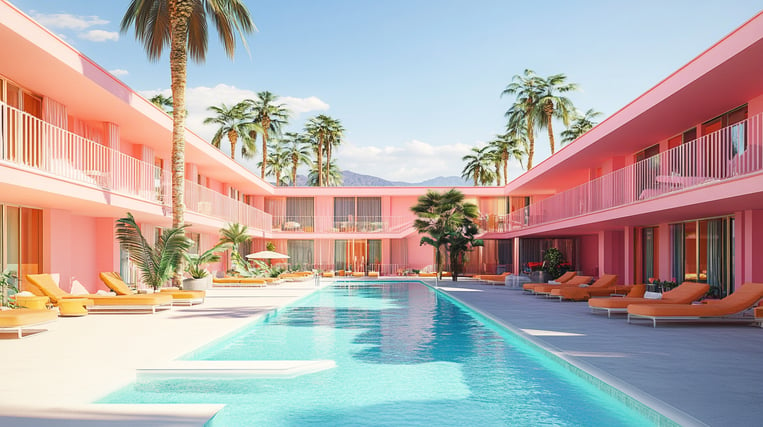Welcome to "The AI Advantage," a monthly series by Michael J. Goldrich, Chief Experience Officer at The Hotels Network and Founder and Chief Advisor at Vivander Advisors. Each month, Michael explores the latest AI trends and innovations shaping the hospitality industry and their impact on hoteliers.
For years, hotel marketers have battled to create compelling visuals with lean budgets, tight timelines, and teams wearing too many hats. You wanted polished imagery. What you got was stock photos and Canva templates.
Enter AI image generation.
With OpenAI's new model, creating brand-aligned, eye-catching images takes minutes, not weeks. You don't need to know Photoshop. You don't even need to know what “layers” are. You just need the right intent and a few smart prompts.
But make no mistake: this isn’t about replacing creativity.
It’s about unleashing it.
Done right, AI image generation doesn’t eliminate the role of the marketer. It amplifies it. It gives you the speed, flexibility, and scale to tell your hotel’s story visually without getting stuck in endless production cycles.
Let’s break down what that means.
What OpenAI's New Model Actually Does
Think of the new OpenAI image generation model as a creative intern who can sketch ideas instantly, adapt to feedback, and work 24/7 without burnout.
At a technical level, the model can:
Generate high-quality, realistic images from a simple text prompt.
Follow brand style guides if given the right instructions (color palettes, mood, theme).
Remix, edit, and enhance existing images.
Create variations, expand scenes, and improve resolution.
In other words, it’s not just spitting out images. It’s co-creating based on the vibe you set.
Want a lobby shot with golden-hour lighting? Done.%20(1).png?width=567&height=378&name=image%20(23)%20(1).png)
Need a family on the beach that matches your brochure colors? Easy.
%20(1).png?width=343&height=343&name=image%20(24)%20(1).png)
Looking for a winter promo image with cozy fireplaces and mountain views? Five minutes.%20(1).png?width=343&height=343&name=image%20(25)%20(1).png)
This is critical, AI can nail the form. You still have to drive the meaning and function.
Why Marketers Are More Important Than Ever
Good design isn’t about making things look good. It's about making them work.
And AI, for all its power, doesn’t understand guest psychology, brand nuance, or the art of storytelling. That’s where you come in.
There are three areas where marketers stay essential:
1. Setting the Creative Intent
AI can execute. But it can’t set the vision.
Your job is to define the why behind the image. What feeling are you trying to evoke? Who are you speaking to? What action do you want a viewer to take?
Without clear intent, AI images will be beautiful and meaningless.
2. Aligning Form with Meaning
Form gets attention. Meaning drives bookings.
It’s one thing to create a dreamy beach scene. It’s another to align that visual with your hotel's positioning as the go-to destination for family adventure or luxury relaxation.
AI will give you images. You still need to choose the ones that reinforce your brand story.
3. Fine-Tuning for Function
An image doesn’t live in a vacuum. It has a job to do.
Whether it's stopping the scroll on Instagram, enhancing a landing page, or supporting a campaign, you need to ensure your images are optimized for their specific role.
That means thinking about load speed, aspect ratio, text overlays, and even alt-text for SEO.
AI can give you 100 drafts. Only you can select the one that moves the business forward.
How to Make AI Image Generation Work for Your Hotel
Start by thinking like an art director, not a designer.Here’s a simple workflow to put into practice:
- Set the vibe. Define your campaign theme, mood, guest segment, and key messaging.
- Prompt with purpose. Write prompts that include emotion, colors, setting, time of day, audience, and style cues.
- Generate options. Use OpenAI’s model to produce 5–10 image variations.
- Curate and refine. Pick the strongest concepts. Adjust prompts if needed for closer alignment.
- Adapt for channels. Crop, size, and enhance images for email, social, web, and print.
- Publish and test. See what resonates. Double down on what works.
You’re not handing over creativity. You’re accelerating it.
Why This Matters for Direct Bookings
Visuals have always been a cornerstone of the booking journey.
Guests are moving faster, browse shorter, and expect higher quality. You don’t get multiple chances to capture their attention.
You get one scroll.
One swipe.
One glance.
AI image generation helps you meet that moment with fresher, more relevant visuals, without drowning your team in production overhead.
It lets you run more campaigns, A/B test faster, and stay visually top of mind. All critical in a world where AI search, voice agents, and operators are filtering guests’ choices before they even reach your site.
Put simply: the more dynamic and brand-aligned your visuals, the better your shot at converting the humans (and the algorithms) that now control the journey.
Final Word
AI won’t replace great marketers.
It will replace marketers who don’t adapt.
OpenAI’s new model is your creative engine. But the roadmap, the feeling, the meaning, the connection, still comes from you.
The hotels that embrace AI for image generation aren’t just going to look better online.
They’re going to move faster.
Test smarter.
Tell richer stories.
And they’ll be the ones guests remember when it's time to book.
The future of hotel marketing isn’t less human. It’s more amplified.
Let's build it.
ABOUT THE AUTHOR
Michael J. Goldrich is THN's Chief Experience Officer and Founder and Chief Advisor of Vivander Advisors, specializing in digital and AI strategies for thought leadership, thought education, and thought solutions. A leading expert in generative AI, he authored Too Many Hats, Too Little Time. After spending nearly two decades in digital marketing and project leadership for multimillion-dollar brands and startups, his expertise in has established him as a sought-after consultant and a pivotal figure in shaping the future of customer engagement within the hospitality sector. Connect with Michael on LinkedIn.






